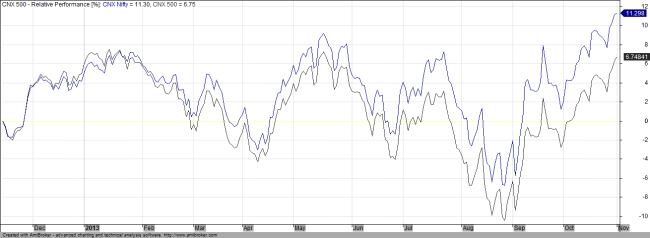Market thoughts on Samvat 2070
With Diwali around the corner, it’s once again time for all the Charlie’s to start picking up stocks that one should buy and which would do well in the coming year. If only predicting the markets were so easy as 1-2-3, you would be reading about them on Forbes Richest 100 instead of seeing them appear on TV.
Let’s first look at the broader picture of how the markets have performed since the last Diwali session. CNX Nifty closed at 5666.95 and while we are strongly above the close of that day as on date, the move has not been easy to digest for many what with the huge swings we have seen develop on either side with the recent slide to 5118 levels marking the low not just for the Diwali to Diwali time frame but also for now marking the low of 2013.
The picture is not so great when one looks at a broader index such as the CNX 500. While that index too is sitting on small gains at the moment, the divergence between CNX Nifty and CNX 500 is pretty clear.
Here is a relative performance comparison between the indices
A 6.74% return by a broad index isn’t much to talk especially in an era where Inflation has been consistently stayed above 9%. And even this had taken quite a hit with returns being in –ve 10% just a couple of months back.
What is interesting is the list of big losing companies which form part of the CNX 500. Topping the list is Core Education which lost a mammoth 94% during the year. Government owned MMTC comes a close second losing 92.42%. Third on the list is Innoventive industries, a company that was strongly recommended not just by a few big brokers but also later was bought by Kenneth Andrade’s IDFC Mutual Fund. Educomp and Gitanjali take the 4th and 5th place in terms of percentage of fall in the last one year. Interestingly both these stocks were investors / traders delight.
Of course, it’s not a losers market all the way with stocks like RCOM, PVR and McDowell giving extraordinary strong gains. While the net result for the index has been positive, the number of stocks which closed in negative outguns those which closed in positive.
Markets have closed above their 2008 highs for the first time signalling an attempt to break-out after a pretty long span of time. The last time we had such a multiyear breakout was in when Nifty broke above the 2000 high in the last week of 2003. While markets travelled a bit higher, the rally petered out and we spent the whole of 2004 more or less in a range bound fashion.
This coming year shall see the biggest and the most vindictively fought elections that we may not have seen since the elections of 1977. I really doubt that we will see a runaway markets since the global scenario still remains weak despite the continued infusion of funds and any rebound that we are seeing in few economies are selective at best. The best hope for a rally will come in only post elections if we can get to as close to a single party majority as possible though even that may not guarantee that we go along the path that bodes well for us.
In the year just gone by, the highest gains were made by sector stocks such as Pharma and FMCG. While they aren’t way outpriced (in historical sense), they still are well in the higher brackets of valuation that we have seen then in quite a few years. This in my opinion should limit the rewards that are on offer by stocks belonging to those sectors.
On the other hand, despite the rise we saw in last couple of days, PSU Banks were one of the worst hit and the valuation gap between private and public sector banks have widened phenomenally. This could over a period of time start to converge to their historical levels though with there being strong doubts on the asset quality of many public sector banks, we may not see a run-away rally either.
Like Analysts on TV, I too can say that action will be stock specific but without actually mentioning the stocks on the horizon which can yield better than average returns, the words speak of emptiness at best and hypocrisy at worst and since my time frame and risk appetite can be different from the readers, I shall refrain from posting any stock recommendations other than saying that the simplest way to be in the market is to trade using ETF’s by buying when we are cheap by historical standards and sell when expensive.



Recent Comments